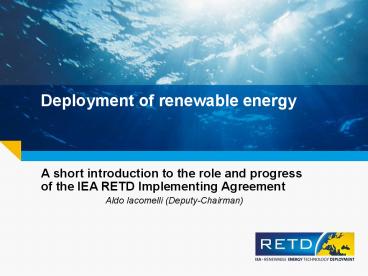Deployment of renewable energy PowerPoint PPT Presentation
1 / 9
Title: Deployment of renewable energy
1
Deployment of renewable energy
- A short introduction to the role and progress of
the IEA RETD Implementing Agreement - Aldo Iacomelli (Deputy-Chairman)
2
Objectives of the RETD
- To elaborate and present options for - best
practice policy measures and mechanisms for cost
reduction, enabling increased use of RE in
competitive energy markets through strengthened
international collaboration. - - innovative business strategies and projects
that will encourage deployment to public and
private sector stakeholders. - - disseminate information and enhance knowledge
about RE deployment to support public and private
sector decision making. - 9 participating countries
- Canada Denmark France Observers
- Germany Ireland Italy Japan, New Zealand
- Netherlands Norway United Kingdom
3
Conclusions from joint RETD/REWP Workshop, Paris,
15 March 2007
- 1. Renewable Energy in Energy Scenarios
- Reference scenarios need to reflect political
decisions in supporting of EE and RE - Scenarios need to demonstrate ways to cope with
constraints on greenhouse gas emissions and to
include the benefits of RE to society - It is an abdication of responsibility and
misleading for potential investors if scenarios
do not include the real technical political
potential of RE. - 2. Bridging the Valley of Death Between RD and
Market Deployment - The public sector must prove an enabling
political, market-oriented framework and stable
long-term policies and payment mechanisms to
allow for the successful integration of RE into
markets. - 3. Scope for International Collaboration
- There is a need to
- establish and promote international RE markets
well adapted to the properties of such
technology - calculate the costs of inaction if RE and EE is
not deployed - contribute to energy security (supply side) with
RE in developed and developing countries with
multilateral cooperation.
4
RETD ongoing activities Project 1 - Renewable
Energy - Cost and Benefits for Society (RECaBS),
www.recabs.org
- Objective
- to estimate the costs and benefits of RE compared
to traditional electricity generating
technologies - to identify improvement possibilities for
renewable energy technologies/sources through the
learning processes. - Main challenges in RECaBS
- Basic cost figures
- Large differences
- Business cycle vs planning prices
- Learning rates
- Value of CO2 emission reduction
- Value of air emissions
- Local conditions
- RE resources are unevenly distributed
- Environmental costs are site dependent
- Evaluated benefits of job-creation depend on
national industries and policies - Methodology not well described, lack of consensus
- Security of supply
- Local benefits/employment
5
RECaBS Cost comparison 2010 and 2025
2010
2025
Discount rate 5 , Fuel prices WEO 2006
(biomass 3 /GJ)
6
Project 2 - Renewable Energy Technology in the
Heating and Cooling Markets
- Objective
- To identify actions which governments and local
authorities could undertake to promote RE for
heating and cooling. - Outcome
- In a joint-report with the IEA Renewable Energy
Working Party, expected July 2007, the following
will be included - 1) A presentation of existing political support
for renewable heating across 12 OECD nations - 2) Analysis and recommendation on good policy
practices - 3) A description of innovative policy
instruments - Standard methods to calculate support needs and a
web-based tool - Best policy practices and recommendations
brochure.
7
Project 2 - Renewable Energy Technology in the
Heating and Cooling Markets (2)
Space and domestic water heating constitute a
significant portion of the energy demand in
buildings, and therefore the final energy supply.
94 Policies are included in this analysis across
12 OECD countries spanning 1990-2007
8
Project 3 - Policy instrument design to reduce RE
financing costs
- Objective
- Identify design elements in policy instruments
that reduce perceived risks of renewable energy
technology (RET) projects. - Give best practice examples of implemented
international, national or regional policy
designs that reduce these perceived risks. - Make concrete recommendations for policy design
- Preliminary recommendation
- Express long-term commitment for RES, then create
a stable support mechanism, that effectively
meets the policy goal, at acceptable levels of
investor risk, and at acceptable social costs
9
RETD Next Steps
- New RETD project activities approved at last ExCo
meeting - Innovative electricity markets to incorporate
variable production, (expected launch June
2007) - RE in global energy scenarios, (expected launch
June 2007) - Risk quantification risk management in RE
projects, (expected launch November 2007) - Next ExCo meeting, October 2007, Canada
- Visit the RETD homepage at www.iea-retd.org

